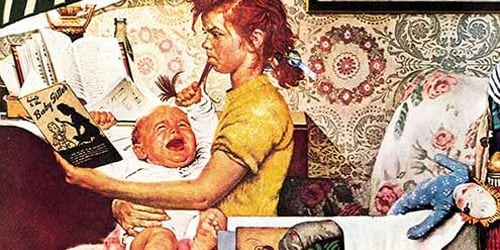
There’s seemingly a lot of cultural daylight (or maybe darkness) between The Babysitter’s Club and When a Stranger Calls.
But maybe not as much as you’d think, if you follow Miriam Forman-Brunell’s argument in her stunning Babysitter: An American History. Forman-Brunell mines cultural imagery and economic realities to create a compelling historical narrative that explores the birth of 20th century “girl culture”, the emergence of the babysitter as a cultural symbol, and the wide-ranging set of responses to that symbol.
Forman-Brunell finds that “child tending” had its beginnings in the ’20s, triggered in part by the increased American emphasis on leisure time and the need for married couples to have a night on the town, unencumbered by the kids. The author argues that this trend coincided with the emergence of the “teenage girl” as a definable demographic.
Adolescent girls soon became the focus of all manner of angst about the changing nature of family, sexuality and the household. Along these lines, Forman-Brunell unearths one of the more bizarre moral panics in American history. During the Second World War many middle class moralists claimed that teenage girls had become “patriotutes”, hanging around military bases with their newly acquired make-up and “sassy” attitudes in hopes of snaring a serviceman.
In general, the author is at her best showing how anxiety about young women’s growing autonomy became conflated with worries about the intrusive and possibly dangerous young adolescent watching the children. By the ’60s, urban legends of babysitters in danger offered ways for a nervous society to attempt to exhort “good behavior” out of the increasingly independent teenage girl.
The well-known urban legend known to folklorists as “The Babysitter and the Man upstairs” well illustrates this point. This story found expression in the 1979 film When a Strangers Calls, with its tale of a babysitter being tormented by repeated threatening calls that ended up coming “from inside the house”.
Forman-Brunell explores this urban legend pretty thoroughly, suggesting that the voice of the maniac on the phone is the voice of a “mutated dad” an angry, frustrated male who has become a terrifying monster in his efforts to reassert his dominance. She further suggests that one expression of these fears emerged in babysitting manuals that warned of “dangerous dads”, predatory older men who might seek to take advantage of the unattached adolescent girl.
A flood of images in the late ’60s and ’70s (and continuing into the present) shows how the advice manuals had tapped into a new set of male fantasies. The 1969 film The Babysitter constructed young women as, in the words of the trailer, “a devil and an angel combined”. Fictional vixens with names like “Candy” and “Kitty” represented both desire and anxiety in a deeply patriarchal culture undergoing a historic transformation as more and more women entered the work force, delayed marriage, or simply refused prescribed roles of marriage and motherhood.
In examining the changing image of the babysitter into the contemporary era, the author gives all the time you would expect to the immensely popular Babysitter’s Club book series, suggesting ways that the image of the “Super Sitter” both allowed girls to appropriate texts in an empowering way, while also introducing them to some very traditional standards of womanhood.
And the babysitter as fantasy and source of anxiety remained. Even as babysitting became less common with the rise of a wealth of new employment opportunities in the ’90s, the babysitter continued to play a role in horror fiction and, through the home video and then DVD market, as the subject of pornographic fantasy. The babysitter has continued to play metonym for a whole host of American middle class anxieties.
Babysitter represents a real triumph of cultural history. The author grounds her exploration of books and films and popular imagery in the economic and demographic realities that helped shape these images. However, the book does have a couple of limitations. First, while Forman-Brunell shows a strong awareness of how the “babysitter in danger” trope played out in urban legend and film, she doesn’t complete the story by showing how the teenage babysitter became the template for the female action hero and “the final girl” in the slasher genre.
This missing element becomes apparent in her discussion of John Carpenter’s Halloween. Carpenter’s film becomes in the author’s explanation a tale in which the maniac strangles a babysitter with a phone cord, illustrating how the telephone has become both representative of girl culture and “a weapon” in the hands of the anxious males who despise that culture’s autonomy.
However, Jamie Lee Curtis’s character, Laurie Strode as the babysitter who successfully fights back against the killer, seems a more obvious thematic element in the film. After 20 years of urban legends and cautionary tales about the dangerous babysitter, Carpenter subverted those stories into a tale of the babysitter striking back.
An overwhelming focus on the role of the babysitter in white middle class life represents another problematic element. Her focus is in part due to the enormous wealth of sources on the white teenage babysitter and partially because of the different morphology of childcare in African American and ethnic communities through much of the 20th century. However, it did seem that a truly comprehensive study should have included more than a brief mention of the economic realities of childcare in minority communities. This would have helped the author fully flesh out her discussion of female empowerment and representations of babysitting.
These quibbles aside, the new paperback edition of Babysitter belongs on the shelf of anyone interested in women’s history and cultural studies. Academics who teach these topics should get it into the hands of their students. Sometimes a babysitter is not just a babysitter…

![Call for Papers: All Things Reconsidered [MUSIC] May-August 2024](https://www.popmatters.com/wp-content/uploads/2024/04/all-things-reconsidered-call-music-may-2024-720x380.jpg)



